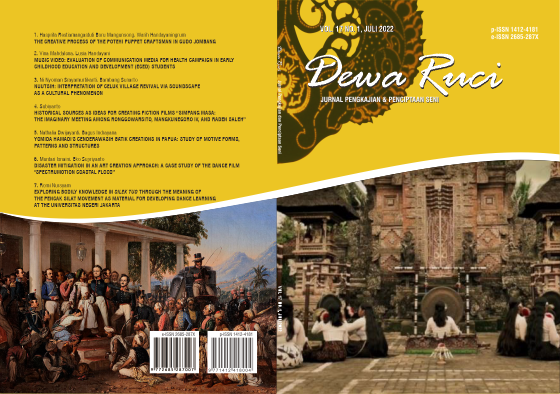Disaster mitigation in an art creation approach: a case study of the dance film "Spectrumotion Coastal Flood"
DOI:
https://doi.org/10.33153/dewaruci.v17i1.3802Keywords:
Film Production, Dance film, Spectrumotion, Coastal Flood, Sayung DemakAbstract
The dance work for the film “Spectrumotion Coastal Flood” is an interpretation of the expressions of sentiment, habits, and ways of survival in Sayung District, Demak Regency, which are inspired by coastal flooding. This study aimed to find experimental methods and studies of dance film media. The basis for making this work are habits that have formed a new culture, such as washing feet, the way humans defecate during floods and surviving with limited activities and routines. The research method uses an empiricism approach. The production process of art creation is carried out with the stages of making an estimate of the form of the work of art as outlined in the design of the creation. The analysis was carried out by exploring knowledge about the body associated with experiments and media studies. The outcomes of this cinema dance piece are capable of evoking feelings and experiences that are appropriate for their intended purpose. Thus, the process of creating the dance film Spectrumotion Coastal Flood, which lasts 14 minutes 51 seconds, successfully presents the empirical experience of the film's dance artistDownloads
References
R. Tandra, A. Sahai, and S. M. Mishra, “What is a Spectrum Hole and What Does it Take to Recognize One?,” Proc. IEEE, vol. 97, no. 5, pp. 824–848, May 2009, doi: 10.1109/JPROC.2009.2015710.
D. H. Roberts, J. Lehar, and J. W. Dreher, “Time Series Analysis with Clean - Part One - Derivation of a Spectrum,” Astron. J., vol. 93, p. 968, Apr. 1987, doi: 10.1086/114383.
L. J. Richardson, D. Deming, K. Horning, S. Seager, and J. Harrington, “A spectrum of an extrasolar planet,” Nature, vol. 445, no. 7130, pp. 892–895, Feb. 2007, doi: 10.1038/nature05636.
J. M. Erlandson, “Racing a Rising Tide: Global Warming, Rising Seas, and the Erosion of Human History,” J. Isl. Coast. Archaeol., vol. 3, no. 2, pp. 167–169, Oct. 2008, doi: 10.1080/15564890802436766.
H. Mei and Y. Yin, “Studies on marine oil spills and their ecological damage,” J. Ocean Univ. China, vol. 8, no. 3, pp. 312–316, Sep. 2009, doi: 10.1007/s11802-009-0312-5.
C. A. G. Tulou, “Foreward: Changing Tides in Ocean Management,” Vt. L. Rev., vol. 28, p. 491, 2003. Available at: Google Scholar.
S. A. Abu El-Magd, A. Maged, and H. I. Farhat, “Hybrid-based Bayesian algorithm and hydrologic indices for flash flood vulnerability assessment in coastal regions: machine learning, risk prediction, and environmental impact,” Environ. Sci. Pollut. Res., Mar. 2022, doi: 10.1007/s11356-022-19903-7.
V. P. Sati and S. Kumar, “Environmental and economic impact of cloudburst-triggered debris flows and flash floods in Uttarakhand Himalaya: a case study,” Geoenvironmental Disasters, vol. 9, no. 1, p. 5, Dec. 2022, doi: 10.1186/s40677-022-00208-3.
M. A. Mallin and C. A. Corbett, “How hurricane attributes determine the extent of environmental effects: Multiple hurricanes and different coastal systems,” Estuaries and Coasts, vol. 29, no. 6, pp. 1046–1061, Dec. 2006, doi: 10.1007/BF02798667.
“The Kinesthetics of Avant-Garde Dance Film: Deren and Harris,” in Envisioning Dance on Film and Video, Routledge, 2013, pp. 53–58. doi: 10.4324/9780203954034-13
M. Kloetzel, “Bodies in place: location as collaborator in dance film,” Int. J. Perform. Arts Digit. Media, vol. 11, no. 1, pp. 18–41, Jan. 2015, doi: 10.1080/14794713.2014.927712.
“Dancing with the Camera: The Dance Cinematographer,” in Envisioning Dance on Film and Video, Routledge, 2013, pp. 250–255. doi: 10.4324/9780203954034-55
R. A. Roberts, “How Do We Quote Black and Brown Bodies? Critical Reflections on Theorizing and Analyzing Embodiments,” Qual. Inq., vol. 19, no. 4, pp. 280–287, Apr. 2013, doi: 10.1177/1077800412471512.
H. Saumaa, “Alys Bentley’s Dance Impulse, Embodied Learning, and the Dancing Mind,” Danc. Chron., vol. 39, no. 3, pp. 249–278, Sep. 2016, doi: 10.1080/01472526.2016.1228352.
A. Sunassee, C. Bokhoree, and A. Patrizio, “Students’ Empathy for the Environment through Eco-Art Place-Based Education: A Review,” Ecologies, vol. 2, no. 2, pp. 214–247, May 2021, doi: 10.3390/ecologies2020013.
W. E. Hipson and S. M. Mohammad, “Emotion dynamics in movie dialogues,” PLoS One, vol. 16, no. 9, p. e0256153, Sep. 2021, doi: 10.1371/journal.pone.0256153.
Hee Lin Wang and Loong-Fah Cheong, “Affective understanding in film,” IEEE Trans. Circuits Syst. Video Technol., vol. 16, no. 6, pp. 689–704, Jun. 2006, doi: 10.1109/TCSVT.2006.873781.
P. Castello-Branco, “Pure Sensations? From Abstract Film to Digital Images,” Animation, vol. 5, no. 1, pp. 25–40, Mar. 2010, doi: 10.1177/1746847709356644.
B. Walmsley, “A reflective perspective on the challenges facing research-led teaching in the performing and creative arts,” Arts Humanit. High. Educ., vol. 12, no. 2–3, pp. 222–233, Apr. 2013, doi: 10.1177/1474022212473944.
H. Smith and R. Dean, Practice-led Research, Research-led Practice in the Creative Arts. Edinburgh University Press, 2009. doi: 10.1515/9780748636303
Downloads
Published
Issue
Section
License
Authors who publish in Dewa Ruci: Jurnal Pengkajian dan Penciptaan Seni agree to the following terms:
- Authors retain copyright and grant the Dewa Ruci: Jurnal Pengkajian dan Penciptaan Seni right of first publication with the work simultaneously licensed under a Creative Commons Attribution License (CC BY-SA 4.0) that allows others to share (copy and redistribute the material in any medium or format) and adapt (remix, transform, and build upon the material) the work for any purpose, even commercially with an acknowledgment of the work's authorship and initial publication in Dewa Ruci: Jurnal Pengkajian dan Penciptaan Seni.
- Authors are able to enter into separate, additional contractual arrangements for the non-exclusive distribution of the journal's published version of the work (e.g., post it to an institutional repository or publish it in a book), with an acknowledgment of its initial publication in Dewa Ruci: Jurnal Pengkajian dan Penciptaan Seni.
- Authors are permitted and encouraged to post their work online (e.g., in institutional repositories or on their website) prior to and during the submission process, as it can lead to productive exchanges, as well as earlier and greater citation of published work (See The Effect of Open Access).
This work is licensed under a Creative Commons Attribution 4.0 International License












